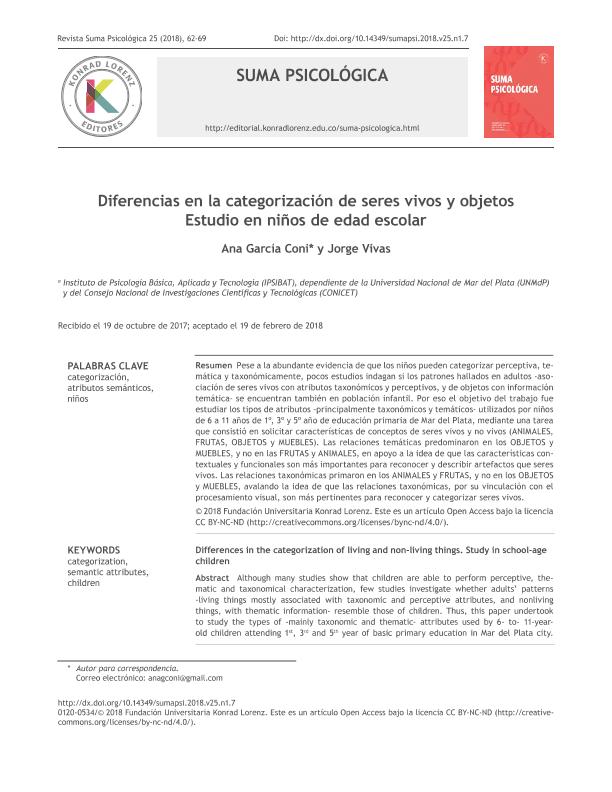Artículo
Pese a la abundante evidencia de que los niños pueden categorizar perceptiva, temática y taxonómicamente, pocos estudios indagan si los patrones hallados en adultos -asociación de seres vivos con atributos taxonómicos y perceptivos, y de objetos con información temática- se encuentran también en población infantil. Por eso el objetivo del trabajo fue estudiar los tipos de atributos -principalmente taxonómicos y temáticos- utilizados por niños de 6 a 11 años de 1º, 3º y 5º año de educación primaria de Mar del Plata, mediante una tarea que consistió en solicitar características de conceptos de seres vivos y no vivos (ANIMALES, FRUTAS, OBJETOS y MUEBLES). Las relaciones temáticas predominaron en los OBJETOS y MUEBLES, y no en las FRUTAS y ANIMALES, en apoyo a la idea de que las características contextuales y funcionales son más importantes para reconocer y describir artefactos que seres vivos. Las relaciones taxonómicas primaron en los ANIMALES y FRUTAS, y no en los OBJETOS y MUEBLES, avalando la idea de que las relaciones taxonómicas, por su vinculación con el procesamiento visual, son más pertinentes para reconocer y categorizar seres vivos. Although many studies show that children are able to perform perceptive, thematic and taxonomical characterization, few studies investigate whether adults’ patterns -living things mostly associated with taxonomic and perceptive attributes, and nonliving things, with thematic information- resemble those of children. Thus, this paper undertook to study the types of -mainly taxonomic and thematic- attributes used by 6- to- 11-yearold children attending 1st, 3rd and 5th year of basic primary education in Mar del Plata city.This was done through a task that consisted of asking for conceptual attributes of living and nonliving things (ANIMALS, FRUITS, OBJECTS, FURNITURE). We found that thematic relations prevailed in OBJECTS and FURNITURE but not in FRUITS and ANIMALS, which matches with the idea that contextual and functional characteristics are more important for artifacts than living things. Likewise, taxonomic relations prevailed in ANIMALS and FRUITS, and its presence was much lower in OBJECTS and FURNITURE. In conclusion, we found a reverse pattern vis-à-vis that of thematic relations, in accordance with the idea that taxonomic relations are more relevant for living things given their relation to visual processing.
Diferencias en la categorización de seres vivos y objetos: Estudio en niños de edad escolar
Título:
Differences in the categorization of living and non-living things: Study in school-age
children
Fecha de publicación:
02/2018
Editorial:
Konrad Lorenz
Revista:
Suma Psicológica
ISSN:
0121-4381
e-ISSN:
2145-9797
Idioma:
Español
Tipo de recurso:
Artículo publicado
Clasificación temática:
Resumen
Palabras clave:
Categorización
,
Atributos semánticos
,
Niños
Archivos asociados
Licencia
Identificadores
Colecciones
Articulos(IPSIBAT)
Articulos de INSTITUTO DE PSICOLOGIA BASICA, APLICADA Y TECNOLOGIA
Articulos de INSTITUTO DE PSICOLOGIA BASICA, APLICADA Y TECNOLOGIA
Citación
García Coni Bosch, Ana Virginia; Vivas, Jorge Ricardo; Diferencias en la categorización de seres vivos y objetos: Estudio en niños de edad escolar; Konrad Lorenz; Suma Psicológica; 25; 1; 2-2018; 62-69
Compartir
Altmétricas




